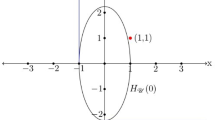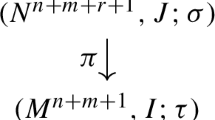Abstract
This paper presents sufficient conditions on one-dimensional (1-D) pole-zero patterns that exhibit a non-negative impulse response (NNIR) for several classes of multi-dimensional (M-D) hyper-planar systems in both the continuous-time and the discrete-time domains. The results provide some intuitive ideas about 1-D to M-D variable substitutions that preserve the non-negativity property of impulse response, as well as the relationship between the impulse response of a transformed M-D system and the impulse response of its 1-D prototype. To the best of our knowledge, this is the first paper in the literature discussing the sufficient conditions on pole-zero patterns that guarantee an NNIR for M-D systems. The sufficient conditions on the pole-zero patterns for the employed 1-D prototype systems represent the most inclusive sufficient conditions that ensure an NNIR. As a result, sufficient conditions on the pole-zero patterns that exhibit an NNIR are revealed for a broad category of M-D systems in this paper. It should be noticed that though there is a significant potential of applications in the area of NNIR M-D systems, NNIR M-D system design has received inadequate attention, which is surprising in view of the abundance of design frameworks developed over decades of research in M-D systems. In response to this inadequacy, this paper provides theoretical background and important guidance in constructing NNIR M-D systems. Specifically, the presented results can be employed to construct NNIR M-D filters using M-D hyper-planar filters as the building blocks. The constructing process is illustrated through a simple design example.
Similar content being viewed by others
References
Aaron M.R., Segers R.G. (1958) A necessary and sufficient condition for a bounded nondecreasing step response. IRE Transactions on Circuit Theory CT-5: 226–227
Benvenuti L., Farina L. (2001) The design of fiber-optic filters. Journal of Lightwave Technology 19(9): 1366–1375
Bruton L.T. (2003) Three-dimensional cone filter banks. IEEE Transactions on Circuits and Systems I: Fundamental Theory and Applications 50(2): 208–216
Bruton L.T., Bartley N.R. (1983) Highly selective three-dimensional recursive beam filters using intersecting resonant planes. IEEE Transactions on Circuits and Systems 30(3): 190–193
de la Barra, B.A.L. (1992). Sufficient conditions for monotonic discrete time step responses. In Proceedings of the 31st IEEE conference on decision and control (pp. 16–18).
de la Barra B.A.L. (1994) On undershoot in siso systems. IEEE Transactions on Automatic Control 39(3): 578–581
de la Barra B.A.L., Salazar F.J. (2002) Discrete-time systems with monotonic step responses and complex conjugate poles and zeros. IEEE Transactions on Automatic Control 47(12): 2098–2101
Dewasurendra, D.A., Liang, Y., Bauer, P.H. (2006). Distributed multidimensional evidence filtering. In Proceedings of the international conference for young researchers (ICYR’06), Poland.
El-Khouq M., Crisalle O.D., Longchamps R. (1993) Influence of zero locations on the number of step-response extrema. Automatica 29(6): 1571–1574
Farina L., Rinaldi S. (2000) Positive linear systems: theory and applications. Wiley Interscience, New York, NY
Fornasini E., Valcher M.E. (1996) On the spectral and combinatorial structure of 2d positive systems. Linear Algebra and its Applications 245: 223–258
Howell J.R. (1997) Some classes of step-response models without extrema. Automatica 33(7): 1427–1428
Janssen A.J.E.M. (1990) Frequency-domain bounds for nonnegative band-limited functions. Philips Journal of Research 45: 325–366
Jayasuriya S., Franchek M.A. (1991) A class of transfer functions with non-negative impulse response. ASME Journal of Dynamic Systems, Measurement Control 113(2): 313–315
Kaczorek T. (2002) Positive 1D and 2D systems. Springer, New York
Kaczorek T. (2009) LMI approach to stability of 2D positive systems. Multidimensional Systems and Signal Processing 20(1): 39–54
Lin S.K., Fang C.J. (1997) Nonovershooting and monotone nondecreasing step responses of a third-order siso linear system. IEEE Transactions on Automatic Control 42(9): 1299–1303
Liu Y., Bauer P. (2010a) Frequency domain limitations in the design of non-negative impulse response filters. IEEE Transactions on Signal Processing 58(9): 4535–4546
Liu Y., Bauer P. (2010b) Fundamental properties of non-negative impulse response filters. IEEE Transactions on Circuits and Systems I: Regular Papers 57(6): 1338–1347
Liu, Y., & Bauer, P.H. (2008). Sufficient conditions for non-negative impulse response of arbitrary-order systems. In IEEE Asian Pacific conference on circuits and systems (APCCAS) (pp. 1410–1413).
Liu, Y., & Bauer, P.H. (2009). On pole-zero patterns of non-negative impulse response discrete-time systems with complex poles and zeros. In 17th IEEE Mediterranean Conference on Control and Automation (MED’09)(pp. 1102–1107). Thessaloniki, Greece.
McWilliams, L.H., & Sain, M.K. (1994). Qualitative features of discrete-time system responses. In Proceedings of the 33rd IEEE conference on decision and control, vol. 1 (pp. 18–23).
Meadows N.G. (1972) Meadows in-line pole-zero conditions to ensure nonnegative impulse response for a class of filter systems. International Journal of Control 15(6): 1033–1039
Nieuwenhuis J. (1998) When to call a linear system nonnegative. Linear Algebra and its Applications 281: 43–58
Rachid A. (1995) Some conditions on zeros to avoid step-response extrema. IEEE Transactions on Automatic Control 40(8): 1501–1503
Valcher M.E. (2000) Nonnegative linear systems in the behavioral approach: the autonomous case. Linear Algebra and its Applications 319(1-3): 147–162
Valcher M.E. (2001) Nonnegative realization of autonomous systems in the behavioral approach. SIAM Journal on Control Optimization 40: 549–556
Zemanian A. (1959) Conditions on pole and zero locations which insure a nondecreasing step response. IRE Transactions Circuit Theory CT-6: 130
Author information
Authors and Affiliations
Corresponding author
Additional information
This work was supported by the Defense Threat Reduction Agency under grant DTRA N00164-07-C-8570. The authors would like to thank DTRA and CRANE NAVAL for their support.
Rights and permissions
About this article
Cite this article
Liu, Y., Bauer, P.H. On the non-negative impulse response of multi-dimensional systems. Multidim Syst Sign Process 25, 95–114 (2014). https://doi.org/10.1007/s11045-012-0192-5
Received:
Revised:
Accepted:
Published:
Issue Date:
DOI: https://doi.org/10.1007/s11045-012-0192-5




